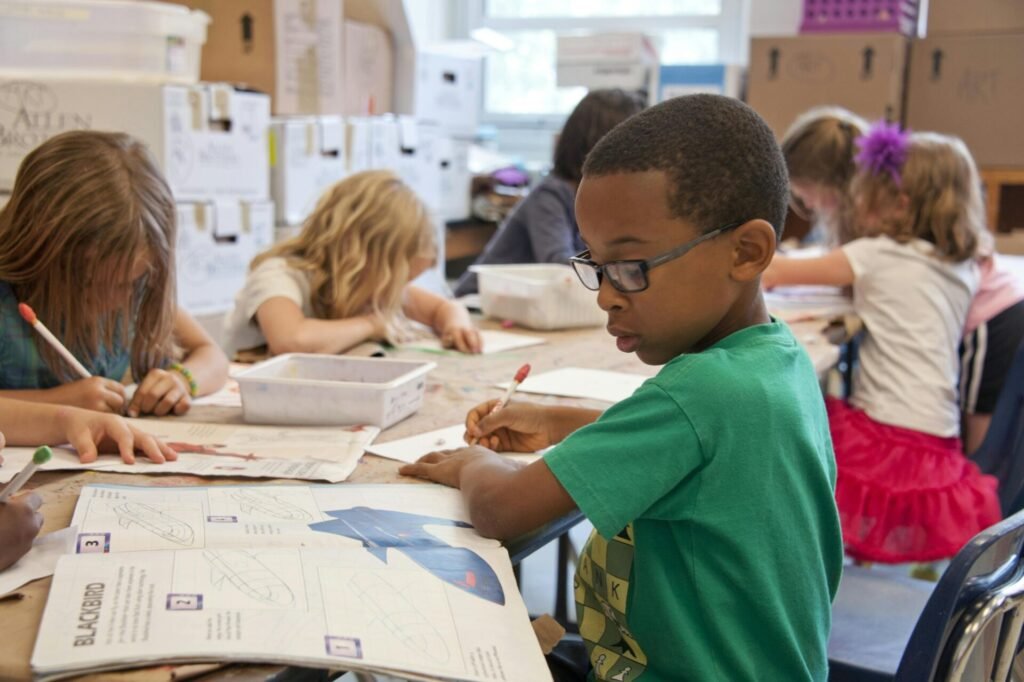Understand the Role of Art in Child Development
This guide explores how to Encourage Artistic Talent in Your Childin a way that fosters confidence, curiosity, and joy—without overwhelming them. Nurturing creativity in children is a delicate balance. As a parent, you want to support your child’s artistic growth without turning their passion into pressure. Whether your child loves to doodle, paint, or fill sketchbooks with imaginative scenes, the key is to create space for exploration while gently guiding their development.
Art is more than just a fun activity—it’s a powerful tool for emotional expression, problem-solving, and cognitive growth. Children who engage in creative activities often develop stronger communication skills, improved focus, and greater self-awareness. Encouraging artistic expression helps your child build resilience, explore identity, and process emotions in a healthy, constructive way.
Let Curiosity Lead the Way
Observe Their Natural Interests
Children are naturally creative, and their artistic leanings often reveal themselves in quiet, spontaneous moments. Instead of steering them toward a specific art form or style, watch what they’re already doing when no one is directing them. Are they constantly sketching animals, crafting storybook worlds, or collecting textures from nature to glue into collages?
Let these instincts lead the way. Offer materials that complement what they love—sketchbooks for doodlers, colored pencils for comic creators, or glue sticks and scrap paper for collage enthusiasts. The goal is to nurture their organic interests, not impose a version of creativity that doesn’t resonate with them.
This approach cultivates ownership, which is the foundation for sustainable creative confidence. When a child feels that their ideas are driving the experience, they’re more likely to stay engaged and proud of what they create
Avoid Over-Scheduling
The modern family calendar fills quickly with classes, clubs, and commitments—but over-structuring a child’s week leaves little space for freeform creativity. Art flourishes when there’s room to pause, tinker, and follow a thought without deadlines or expectations.
Instead of crowding their schedule with back-to-back activities, protect open blocks of time where they can freely choose what to explore. These quiet hours are where creativity thrives—in messy sketchbook pages, accidental color experiments, or imaginative storytelling that starts with a single squiggle.
Leaving this space unscripted gives them the chance to develop an artistic identity that’s authentic and self-motivated—not shaped by someone else’s agenda.
Create a Supportive Creative Environment
Set Up a Dedicated Art Space
Creativity flourishes when it has a home. Carve out a cozy, consistent spot in your home that your child can call their own art zone. This doesn’t need to be a studio-worthy setup—just a small table, a comfortable chair, and natural light or a bright desk lamp can go a long way. Keep essential materials within reach in open bins or drawers: blank paper, sketchbooks, colored pencils, markers, paint sets, brushes, scissors, and glue.
By having a permanent space, you send a quiet but powerful message: creative expression belongs here. It invites your child to experiment freely without having to ask or wait. Over time, that environment becomes a familiar, comforting space where ideas can take shape naturally.
Introduce a Sketchbook Early
A sketchbook is more than a drawing pad—it’s a private creative sanctuary. Introducing one early gives your child a safe, judgment-free space where they can draw, scribble, paste, plan, and express whatever is on their mind. It removes the pressure of “making something good” and replaces it with permission to simply make.
Encourage them to treat it like a visual diary: a place for wild ideas, silly characters, notes from dreams, or little color experiments. Let them personalize the cover with stickers, drawings, or their name in bold letters. This sense of ownership deepens their emotional connection to the habit.
Over time, flipping back through filled pages shows visible proof of progress and effort—a quiet but powerful source of motivation. They’ll see how far they’ve come, in their own lines and colors, and begin to trust their creative instincts.
Encourage Without Controlling
Praise the Process, Not Just the Product
How we respond to a child’s artwork can shape the way they view creativity itself. Rather than defaulting to generic praise like “That’s beautiful,” try offering comments that recognize their choices and efforts:
- “I noticed how you filled the entire page—what made you decide to do that?”
- “Those colors really stand out—how did you come up with that combination?”
This type of feedback encourages children to reflect on their process and take pride in their thinking, not just in reaching a “correct” or impressive result. When we affirm their curiosity, problem-solving, and perseverance, we’re helping them develop internal motivation—the kind that stays with them long after the drawing is done.
Ask Open-Ended Questions
When your child shares their work, let curiosity lead the conversation. Avoid jumping to explanations or interpretations—instead, give them the floor to explain what they created and why. Asking questions like:
- “What inspired this piece?”
- “Where did you start on the page?”
- “If you added one more thing, what would it be?”
These questions encourage creative thinking, storytelling, and artistic ownership. They also show your child that their perspective is valued, which deepens their emotional connection to their work.
Avoid Over-Correction
Even with the best intentions, offering unsolicited advice can undercut your child’s creative confidence. When a face is out of proportion or the sky is green, let it be. These creative “mistakes” are often conscious decisions or part of their learning process. Resisting the urge to fix or guide allows space for experimentation, resilience, and self-discovery.
Over time, they’ll learn to assess their own work more critically—but on their terms. Your job is to hold the space, not hold the pencil.
Offer Opportunities Without Pressure
Provide a Variety of Materials
One of the most empowering ways to support your child’s artistic journey is to expose them to a wide range of materials—without tying those materials to performance or expectation. Offer watercolor paints, oil pastels, markers, collage bits, modeling clay, and even simple tools like cardboard and natural objects. When possible, include digital drawing tablets or apps to show that art isn’t limited to traditional formats.
Let your child take the lead in deciding what to use and how to use it. Some children thrive with fluid paint and big gestures; others find focus in tiny, intricate line work. Neither approach is better—what matters is that the materials invite exploration rather than dictate direction. This kind of open access fosters personal discovery and builds confidence across creative domains.
Visit Museums and Art Events
Bringing your child into spaces where art is celebrated sends a strong message: art matters, and so does your expression. Local museums, galleries, pop-up mural projects, or community chalk festivals offer inspiration in abundance—no textbook required. You don’t need to give a lecture while you’re there. Simply let them wander, notice what they react to, and strike up natural conversations based on curiosity.
Invite them to bring their sketchbook along and respond to the art in real time. It doesn’t have to be a replica—they can capture the mood, shapes, colors, or even something completely imaginative inspired by what they’ve seen. This habit turns observation into action and validates their unique point of view.
Enroll in Classes When They’re Ready
If your child shows sustained interest or asks to “get better” at art, that’s the time to explore formal instruction. Look for programs that emphasize process over perfection, where creativity and self-expression are valued more than technical accuracy or competition.
The best early art classes feel like extensions of play, encouraging experimentation while gently introducing new techniques. Avoid rigid, critique-heavy environments—especially for younger children—as these can dampen their enthusiasm or trigger self-doubt. When your child feels ready, a supportive class can become a new sandbox for growth—not a stage for performance.

credit: haseeb
Support Their Artistic Identity
Display Their Work at Home
When you showcase your child’s art at home, you’re doing more than decorating—you’re affirming their identity as a creative person. A simple magnet on the fridge, a frame in the hallway, or a rotating corkboard gallery all send the message: your ideas matter, and we’re proud of them. You don’t need to wait for a “masterpiece.” Highlight spontaneous sketches, process-driven pieces, or even funny mistakes that made them laugh.
Involving them in choosing what to display empowers them to reflect on their own growth and aesthetic preferences. Over time, their artwork becomes a timeline of their imagination—and a celebration of their unique voice.
Encourage Storytelling Through Art
Art becomes even more meaningful when it’s tied to a narrative. Encourage your child to invent characters, dream up imaginary places, or create sequential stories across several pages. A sketchbook is the perfect container for these evolving ideas—whether it’s an illustrated journal, a fantasy map, or a comic strip with recurring characters.
Prompting with questions like “What’s happening in this scene?” or “Who is this character friends with?” deepens their connection to the work. It’s not just about drawing—it’s about authorship, empathy, and world-building through pictures.
These narrative exercises also strengthen literacy skills and help your child see themselves as both an artist and a storyteller.
Respect Their Creative Boundaries
Not every drawing needs to be shared. Some pieces are private or experimental, and pushing for explanation can unintentionally make your child self-conscious. If they decline to show something, respect that space. Let them know it’s okay to create just for themselves—that the act of creating is valuable, even when it’s unseen.
This permission reinforces autonomy and helps them maintain a healthy relationship with their art—free from constant evaluation. Over time, they’ll be more willing to share on their own terms, when it feels authentic to do so.

Sketchbooks.org | TIPS AND HACKS
Getting the Eyes Right | Why Eyes Can Make or Break a Portrait
Look Into My EYES In portrait art, getting the eyes right is far more than just rendering pupils and eyelashes—it’s capturing the heart of human expression. The eyes serve as the emotional and structural anchor...
Frequently Asked Questions
How do I know if my child has artistic talent?
Look for signs of curiosity, persistence, and joy in creative activities—not just technical skill.
Should I correct my child’s drawings?
No, it’s better to let them explore freely and develop their own style through experimentation.
What age should my child start using a sketchbook?
As early as preschool—just choose age-appropriate materials and let them use it however they like.
How often should I encourage them to draw?
Offer regular opportunities, but let them choose when and how often to engage.
Are art classes necessary for young kids?
Not always—unstructured exploration is often more beneficial in early stages.
What if my child loses interest in art?
That’s normal. Let them take breaks and return when they’re ready—creativity isn’t linear.
How can I help without being overbearing?
Be present, ask questions, and provide materials—without directing the outcome.
Is digital art okay for kids?
Absolutely. Tablets and drawing apps can be great tools when balanced with traditional media.
Final Thoughts
Supporting your child’s artistic journey isn’t about reaching milestones or building a portfolio—it’s about fostering a space where creativity feels safe, personal, and exciting. When you offer the right tools, like a sketchbook; set gentle boundaries around encouragement; and remain present without interfering, you create an environment where authentic expression can grow.
Remember: true artistic confidence doesn’t come from praise or precision—it comes from freedom to explore, fail, laugh, and try again. Let your child’s sketchbook be filled with scribbles, surprises, and stories only they can tell.
Your quiet support today may just be what keeps their creative light glowing for a lifetime.
Ready to Share Your Work?














Important reminder: It’s their creative journey, not mine to control.